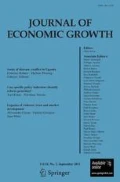Abstract
Acknowledging that wage inequality and intergenerational mobility are strongly interrelated, this paper presents a model in which both are jointly determined. The model enables us to study how inequality and mobility are affected by exogenous changes and what determines their correlation. A main implication of the model is that differences in the amount of public subsidies to education and educational quality produce cross-country patterns with a negative correlation between inequality and mobility. Differences in the labor market, like differences in skill-biased technology or wage compression instead produce a positive correlation. The predictions of the model are found to be consistent with various empirical observations on mobility and inequality.
Similar content being viewed by others
References
Aghion P., Bolton P. (1997). A theory of trickle-down growth and development. The Review of Economic Studies 64(2): 151–172
Alesina A., Glaeser E., Sacerdote B. (2005). Work and leisure in the U.S. and Europe: Why so different? NBER Macroeconomics Annual 20: 1–64
Alesina A., Rodrik D. (1994). Distributive politics and economic growth. The Quarterly Journal of Economics 109(2): 465–490
Baland J.M., Robinson J.A. (2000). Is child labor inefficient? Journal of Political Economy 108(4): 663–679
Banerjee A.V., Newman A.F. (1993). Occupational choice and the process of development. Journal of Political Economy 101(2): 274–298
Barro R.J. (2000). Inequality and growth in a panel of countries. Journal of Economic Growth 5(1): 5–32
Benabou R. (2001). Social mobility and the demand for redistribution: The poum hypothesis. The Quarterly Journal of Economics 116(2): 447–487
Benabou R. (2002). Tax and education policy in a heterogeneous-agent economy: What levels of redistribution maximize growth and efficiency? Econometrica 70(2): 481–517
Björklund A., Eriksson T., Jantti M., Raaum O., Osterbacka E. (2002). Brother correlations in earnings in Demark, Finland, Norway and Sweden compared to the United States. Journal of Population Economics 15(4): 757–772
Blanchard O.J., Wolfers J. (2000). The role of shocks and institutions in the rise of european unemployment: The aggregate evidence. Economic Journal 110: 1–33
Blanden, J., Gregg, P., & Machin, S. (2005). Intergenerational mobility in Europe and North America—a report for the Sutton Trust. Centre for Economic Performance, London School of Economics.
Blau F., Kahn L.M. (1996). International differences in male wage inequality: Institutions and market forces. Journal of Political Economy 104(4): 791–837
Blau F., Kahn L. (2002). At home and abroad: U.S. labor markets in international perspective. Russell Sage, New York, NY
Checchi D., Ichino A., Rustichini A. (1999). More equal but less mobile? Education financing and intergenerational mobility in Italy and in the US. Journal of Public Economics 74(3: 351–393
Comi, S. (2003). Intergenerational mobility in Europe: Evidence from ECHP. Mimeo, Univerista degli studi di Milano.
Cooper S., Durlauf S.N., Johnson P.A. (1993). On the evolution of economic status across generations. American Statistical Association Proceedings of Business and Economics 83: 50–58
Dahan M., Gaviria A. (2001). Sibling correlations and intergenerational mobility in Latin America. Economic Development & Cultural Change 49(3): 537–554
Doepke M., Zilibotti F. (2005). The macroeconomics of child labor regulation. American Economic Review 95: 1492–1524
Durlauf S.N. (1996). A theory of persistent income inequality. Journal of Economic Growth 1(1): 75–93
Erikson, C. L., Ichino, A. (1994). Wage differentials in Italy: Market forces, institutions, and inflation. NBER Working Paper No. 4922, 1994.
Fender J., Wang P. (2003). Educational policy in a credit constrained economy with skill heterogeneity. International Economic Review 44: 939–964
Fernandez R., Rogerson R. (1995). On the political economy of education subsidies. Review of Economic Studies 62(2): 249–262
Fernandez R., Rogerson R. (1998). Public education and income distribution: A dynamic quantitative evaluation of education-finance reform. American Economic Review 88(4): 813–833
Galor O., Zeira J. (1993). Income distribution and macroeconomics. The Review of Economic Studies 60(1): 35–52
Galor O., Tsiddon D. (1997). Technological progress, mobility, and economic growth. American Economic Review 87: 363–382
Glomm G., Ravikumar B. (1992). Public versus private investment in human capital, endogenous growth and income inequality. Journal of Political Economy 100(4): 813–834
Güell, M., Rodríguez Mora, J. V., & Telmer, C. (2007). Intergenerational mobility and the informative content of surnames. CEPR DP 6316.
Hassler J., Rodríguez Mora J.V. (2000). Intelligence, social mobility, and growth. American Economic Review 90(4): 888–908
Hornstein A., Krusell P. (2003). Implications of the capital-embodiment revolution for directed R&D and wage inequality. Federal Reserve Bank of Richmond Economic Quarterly 89(4): 25–50
Lambert, P., Prandy, K., & Bottero, W. (2007). By slow degrees: Two centuries of social reproduction and mobility in britain. Sociological Research Online, 12(1).
Loury G.C. (1981). Intergenerational transfers and the distribution of earnings. Econometrica 49(4): 843–867
Maoz Y.D., Moav O. (1999). Intergenerational mobility and the process of development. Economic Journal 109(458): 677–697
Mayer, S. E., & Lopoo, L. M. (2001). Has the intergenerational transmission of economic status changed? Mimeo.
Mourre, G. (2005). Wage compression and employment in Europe: First evidence from the structure of earnings survey 2002. Economic Papers no. 232, September 2005, European Commission, Directorate-General for Economic and Financial Affairs.
Owen A.L., Weil D.N. (1998). Intergenerational earnings mobility, inequality and growth. Journal of Monetary Economics 41(1): 71–104
Perotti R. (1996). Growth, income distribution, and democracy: What the data say. Journal of Economic Growth 1(2): 149–187
Persson, T., & Tabellini, G. Is inequality harmful for growth? American Economic Review, 84(3), 600–621.
Ryan P. (2001). The school-to-work transition: A cross-national perspective. Journal of Economic Literature 39(1): 34–92
Solon, G. (1999). Intergenerational mobility in the labor market. Handbook of Labor Economics (Vol. 3A). In O. Ashenfelter & D. Card (Eds.), Handbooks in economics (Vol. 5, pp. 1761–1800). Amsterdam; New York and Oxford: Elsevier Science, North-Holland.
Solon G. (2004). A model of intergenerational mobility variation over time and place. In: Corak M. (eds) Generational income mobility in North America and Europe. Cambridge University Press, Cambridge
Author information
Authors and Affiliations
Corresponding author
Rights and permissions
About this article
Cite this article
Hassler, J., Rodríguez Mora, J.V. & Zeira, J. Inequality and mobility. J Econ Growth 12, 235–259 (2007). https://doi.org/10.1007/s10887-007-9019-x
Published:
Issue Date:
DOI: https://doi.org/10.1007/s10887-007-9019-x




